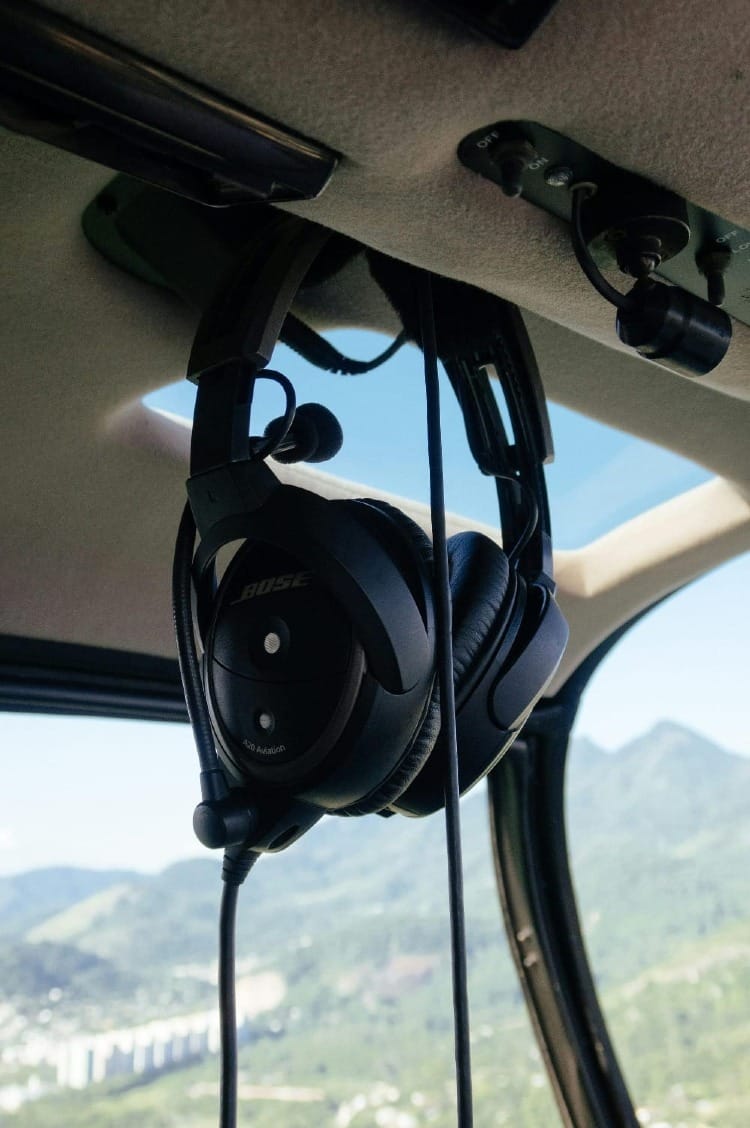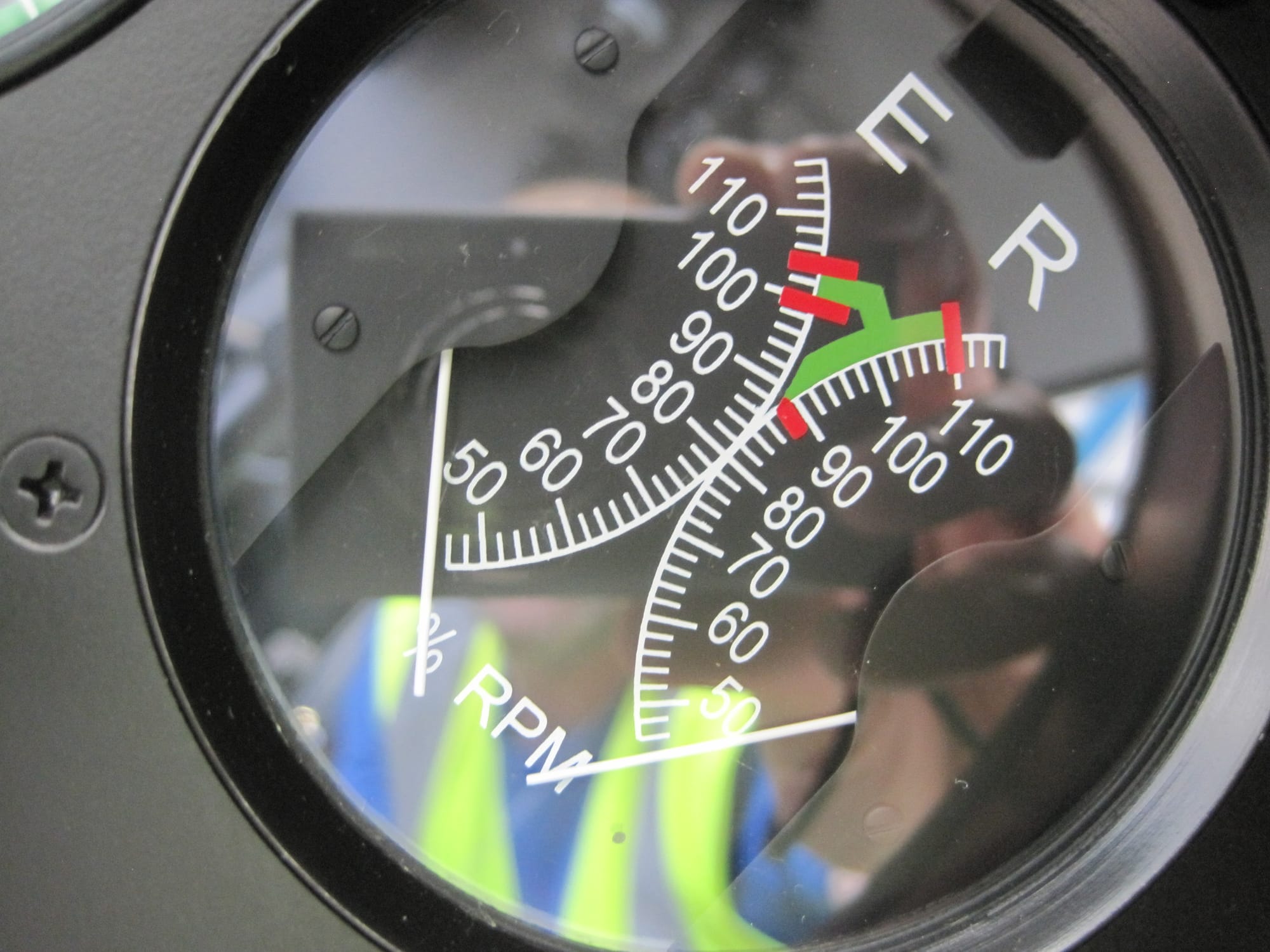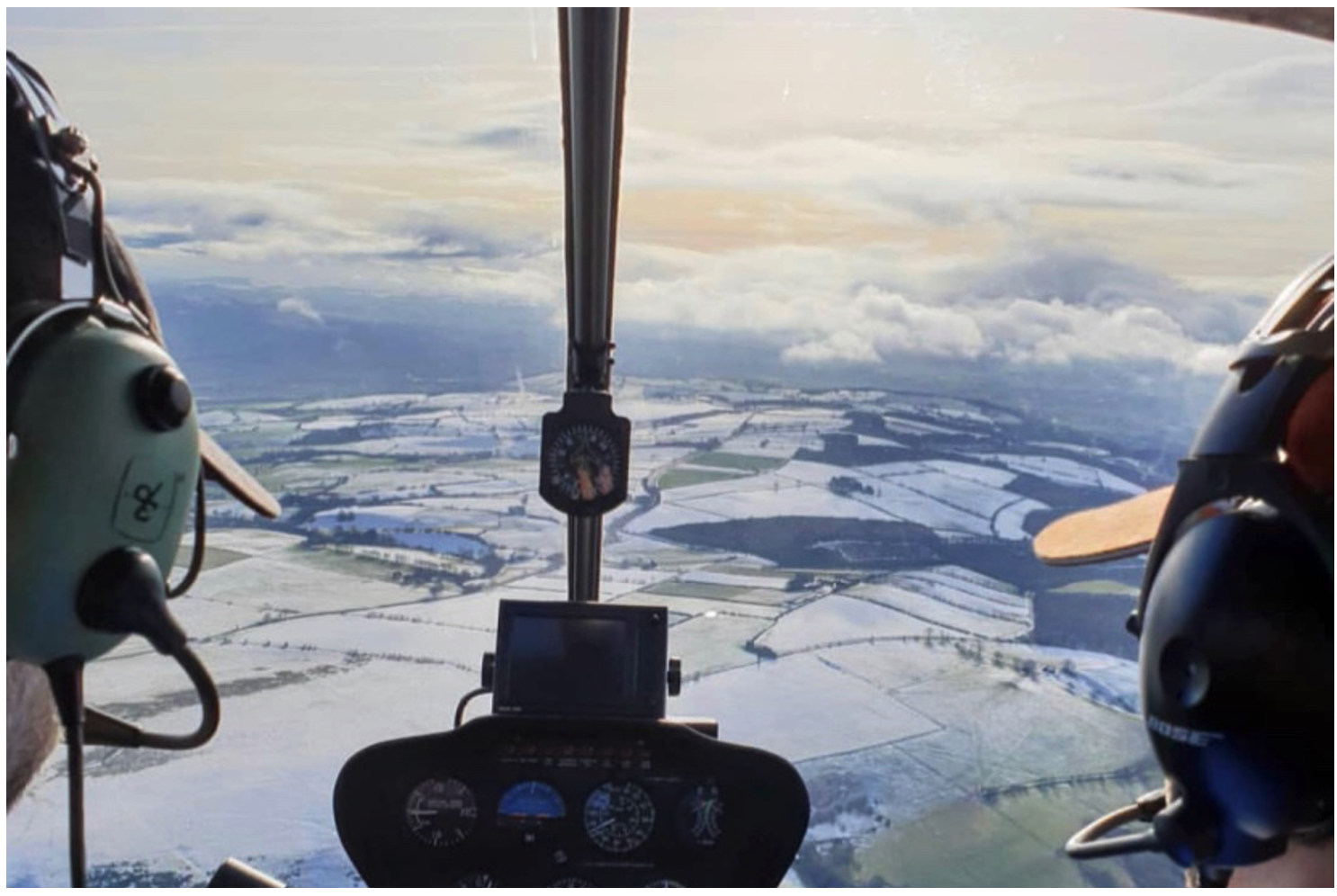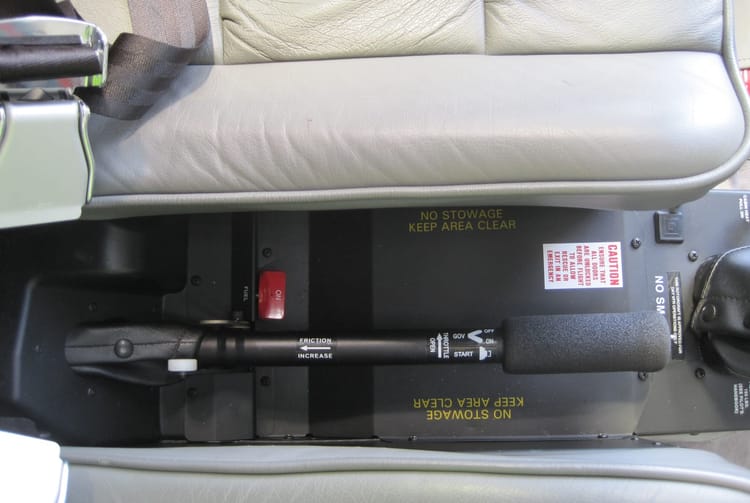Article: Noise-cancelling headsets: As good as they sound?

This article explores the risks of using active noise reduction (ANR) headsets in helicopter operations. By dampening critical auditory cues such as changes in engine and rotor RPM the use of these headsets has contributed to helicopter accidents. Should a high quality passive headset be the preferred choice for helicopter pilots?
Noise-cancelling headsets: As good as they sound?
For years my audible experience of helicopter flight was filtered through cheap and battered headsets that came with the R22s I rented. The radios were old, always crackly and barely worked when the aircraft had been sitting in the sun. And to add to the difficulty I flew from a busy commercial airport where communication was regular and demanding. I longed to some day fly with an operator that provided noise-cancelling headsets. Or, once professionally qualified, to fly enough – and so earn enough – to justify the cost of buying my own ANR set.
Noise-cancellation (NC), also known as active noise reduction (ANR) or active noise control (ANC) is a technology built into “noise cancelling” headsets. Here electronic components are integrated into a conventional passive ear defender. In basic terms, a sensor detects surrounding noise which is analysed and a sound of opposite phase is generated by a loudspeaker. This destructively interferes with the surrounding sound waves to ‘cancel’ the surrounding noise. The net result is that the person wearing the headset experiences considerably less surrounding noise than would be experienced with the passive ear defender alone.
With my ANR headset I was sure I wouldn’t need the radio and intercom turned up to damaging levels so I could hear them above the helicopter and wind noise. A reduction in distraction, workload and fatigue would all follow. A win in anyone’s book.
So I was hoping for great things when I finally started work for an operator that did equip their helicopters with ANR headsets. Yet come day one I found I wasn’t revelling in the relative peace. I felt unsettled. And this was whilst flying in what otherwise were familiar circumstances. Wind noise, engine noise, rotor noise: All had taken a big step into the auditory background. This made the flight experience unfamiliar and, ironically, distracting. I found myself constantly checking the tachometer and warning lights to ward off a niggling feeling that all was not as it should be. With hindsight this was perhaps not surprising. After all, the wind, engine and rotor noises all provide information on the functioning of the helicopter and the immediate flight condition. So they’re important cues for the pilot. Dampen these and it’s understandable that it takes a bit of getting used to.
The trouble was even when I was used to it I was still getting less information through my ears about the state of the helicopter. Most obviously I was slower in recognising uncommanded changes in engine and rotor RPM. And to me this is a problem, a potential flight risk. It was whilst instructing that I first noticed this – during both Run-Up and autorotation.
During Run-Up in the R22, the engine RPM is set to 70-75% until the engine gages are indicating a reading in the green arc. If not properly managed by the pilot the RPM may be set a little high and may ‘creep’ up to and above 80%. At this point the governor will increase the RPM to operating speed. As the pilot is unprepared for this and the control frictions are still on it can be catastrophic (1,2). Unless the pilot is fixated on the tachometer, the first indication of RPM creep will be through hearing the change in engine and rotor noise. When instructing and wearing a passive headset I’d easily hear it – it would catch my attention. I’d then check the tachometer and see if the handling pilot would notice the increase before the governor kicked in and took the RPM to operating speed. If I was wearing an ANR headset I’d need to concentrate to hear the RPM creep, even though I’m sitting there with little else to distract me. A handling pilot is likely to be busy setting RT frequencies or listening to airport information at this time. They’re going to be even less likely to detect the change in sound in whatever headset they’re wearing. But, I’d suggest, particularly if it has ANR.
Practice autorotations are another scenario in which an instructor needs to be ready to jump in to control RPM. As the student flares or banks the helicopter the rotor RPM will increase and if the manoeuvre is aggressive the RPM is at risk of exceeding safe limits. On the flip side, coming out of a flare or bank will unload the main rotor and might cause the rotor RPM to drop below safe limits. Many a time have I caused my instructors to have to quickly raise the collective lever to prevent the rotor RPM going too high as I threw the long suffering R22 around the sky trying to ‘make’ my chosen landing spot. I’m not sure how I was monitoring the rotor RPM back then – other than poorly – but later, when instructing, my hearing played a big part in doing this. And with ANR I’d find there was a greater rotor RPM change before I’d notice a sound change. I’d be behind the curve. I had to adapt by looking earlier at the tachometer. Better handling pilots than me will have more of a feel for how the severity of flare/bank or recovery to level flight combines with the lever position to affect rotor RPM. For them a delay or reduction in hearing an RPM change might be less of an issue. But for me it’s another entry in the negative column for ANR.

Of course these are my observations and have no objective measurement to back them up. Yet they are in line with the properties of ANR: It is effective at reducing low frequency noise as generated by the engine and particularly the rotor system (3,4). And it is most effective against repetitive or continuous noises that are relatively invariant or changing only slowly (3).
Given this it’s perhaps not surprising that the use of ANR headsets has been causally associated with several helicopter accidents.
Case 1 The R44 helicopter was on a scenic flight when there was a rapid decrease in main rotor speed and the low RPM horn and warning light came on. The pilot opened the throttle and lowered the collective but this failed to increase rotor speed. The pilot then carried out an autorotative descent to the ground. The safety analysis did not determine a reason for the low RPM but found that the use of a noise-cancelling headset by the pilot “may have masked any abnormal sounds from the helicopter prior to the low rotor RPM warning.”
Case 2 A student pilot wearing an ANR headset was intending to carry out a solo circuit of the airfield in an R22. He raised the collective lever in order to take off to the hover. Whilst doing so he focused on the manifold air pressure (MAP) gauge to ensure the MAP was kept within safe limits. On reading 20” MAP, with the helicopter still on the ground, the pilot felt a violent shudder and lowered the collective lever. The tail boom had broken into 3 portions and the tail rotor was resting on the ground. The investigation concluded that this was a result of the RPM having increased to 132%, the over speeding most likely being due to incorrect management of the throttle. The pilot did not detect the sound of the increasing RPM as a result of the ANR headset reducing audio cues and having his attention focused on the MAP gauge.
Case 3 The R44 was on a ferry flight with only the pilot on board. The aircraft had a faulty alternator and a failing battery. As the supplied voltage from the battery decreased the dual engine/main rotor tachometer progressively under read and the governor failed. This and the throttle inputs from the pilot to compensate for the indicated decrease in engine RPM resulted in an engine overspeed. “The noise-cancelling headset worn by the pilot may have masked changes in the ‘normal’ sounds of the helicopter.”
Safety Lessons:
The use of an ANR headset may mask changes in the normal sounds of the helicopter (Cases 1-3).
This may delay or prevent the pilot becoming aware of a handling error or mechanical problem with the helicopter. By reducing the auditory information available to the pilot it may hinder their ability to detect a developing problem or to recognise the nature of an immediate one.
Given the importance of being able to very quickly recognise a deviation from operational engine and rotor RPM it’s troubling that there are circumstances in which ANR headsets may hinder this.
Increasing RPM: Not recognising an increase in engine and rotor RPM can severely damage the helicopter over several seconds or minutes depending on the extent of the overspeed (5; Cases 2,3). If you’re fortunate enough to be flying a Robinson helicopter built since May 2021 it will have a headset audio alert for high RPM (6). This may prevent incidents as described in Cases 2 and 3.
Decreasing RPM: A delay in hearing sounds leading to or associated with an engine or drive train failure (Case 1) or with a handling error causing a decrease in RPM (7) has the potential to lead to rotor stall. And this is catastrophic. The pilot of an R22 or R44 has a very limited time to respond to such a failure or error so any reduction or delay in awareness of one must be avoided (8-10).
Cognitive demands may combine with noise reduction by ANR to further reduce the likelihood of being aware of abnormal sounds (Case 2).
Piloting a helicopter is difficult. If you’re reading this you very likely know through experience that it is often cognitively challenging and can at times be stressful. In these situations pilots – being mere humans – are less likely to become aware of unexpected sounds even when they are prominent (11). So when intently focussed on a particular task or stressed by the flight situation our attention narrows and we become less aware of sounds around us. The use of ANR may only serve to exacerbate this limitation for low frequency noise.
If using an ANR headset for the first time, fly with an instructor.
This suggestion is based on my experience and, in general, would apply more the fewer hours you have in the right hand seat. The security provided by an instructor gives you a chance to become used to the unfamiliar auditory environment under minimally demanding flight conditions.
And whether passive or ANR, ensure all headsets are functional before engine start.
Most of us with more than a few hours under our belts have done it. Rotors running on the ground and not doing what we are meant to be doing as we are trying to get a headset to work. This is a distraction and distractions like this cause accidents (12). It’s an easy fix, make sure all the headsets you need for the flight work before you start the engine.
So where does that leave us?
There is little doubt that there are potentially serious downsides to the use of an ANR headset when piloting an R22 or R44, and possibly other helicopter types.
And so we are left with a conflict. On one side, we want to wear an ANR headset to protect our hearing to a greater extent than is achievable with a passive headset. Doing so can also aid communication and reduce fatigue, and there may be days in which this is enough to tip the scales in favour of ANR. After all, we don’t know about the accidents avoided through the pilot being less tired and being able to hear more clearly. On the flip side, we depend entirely on the maintenance of operational engine and rotor RPM to keep us in the air and to protect the engine, transmission and rotor system. So we need to be as sensitive as practically possible to RPM changes. This would call for avoiding ANR.
So it comes down to being aware of the pros and cons and making a choice based on the type and duration of the flying that you do. For me, in general, a high quality passive headset is better than an ANR model. To tip the balance in favour of ANR I would need to not be teaching and to be flying more than a couple of hours in the day.

Sources of information
The Helicopter Safety Project Articles are built with gratitude on the work of others: The investigators of air accidents and the many pilots who, in the best spirit of promoting aviation safety, spoke candidly about the errors they had made in the accident chain of events. The main source material is investigation reports published on Government aviation accident investigation sites. For accuracy in summarising each report I’ve stuck closely to the wording used within. At times I’ve presented short pieces of text verbatim and in these cases I’ve put the text in quotation marks. Each investigation report is referenced below and can be viewed by searching the accident number and the aircraft registration via an internet search engine or through the relevant government organisation. As well as the documented reports, in some Articles I've thrown in a lesson learnt from my own experiences of flying and of teaching flying. Where primary research papers and reviews are referenced they can be accessed through PubMed – the search engine on life sciences and biomedical topics maintained by the United States National Library of Medicine.
Air accident Cases:
Case 1. Australian Transport Safety Bureau. Aviation Occurrence Investigation AO-2017-041. Robinson R44 Raven II, VH-MQE.
Case 2. UK Air Accidents Investigation Branch. Bulletin 3/2001. Investigation report EW/C2000/9/3. Robinson R22, G-BYHE.
Case 3. Australian Transport Safety Bureau. Aviation Occurrence Investigation AO-2012-096. Robinson R44 Raven II, VH-CYH.
Other references:
1. UK Air Accidents Investigation Branch. Bulletin 2/2008 . Investigation report EW/G2007/07/07. Robinson R22, G-OBIL.
2. UK Air Accidents Investigation Branch. Bulletin 5/2016 . Investigation report EW/G2016/02/14. Robinson R22, G-EFON
3. Casali JG, Robinson, GS, Dabney EC, Gauger D. Effect of Electronic ANR and Conventional Hearing Protectors on Vehicle Backup Alarm Detection in Noise. Human Factors. Vol. 46, No. 1, Spring 2004, pp. 1–10. DOI: 10.1518/hfes.46.1.1.30387.
4. Novak D, Bucak T, and Miljković D. Comparative helicopter noise analysis in static an in-flight conditions. Acoustics ’08 Paris, pp.4061-4064. 2008.
5. Robinson Helicopter Company. Safety Notice SN-36.
6. New Robinsons include enhance audio alerts. Robinsonheli,com May 11, 2021. https://www.robinsonheli.com/press/new-robinsons-include-audio-alerts (accessed 28th May 2025).
7. Causes of Low Rotor RPM. In SFAR 73 - What Training Do I Need Before I Can Fly R22 & R44 Helicopters? SFAR 73 Awareness Training. Helicopter Training Videos. https://www.youtube.com/watch?v=RJ8SAnwxD6I (accessed 28th May 2025).
8. Robinson Helicopter Company. Safety Notice SN-10.
9. UK Air Accidents Investigation Branch. Bulletin 10/2001. Investigation report EW/C2000/12/3. Robinson R22 Beta, G-BNUZ.
10. Gyronimo Systems Training video: Stored Energy II. https://www.gyronimosystems.com/SFAR/ (accessed 28th May 2025).
11. Dehais F, Causse M, Vachon F, Régis N, Menant E, Tremblay S. Failure to detect critical auditory alerts in the cockpit: evidence for inattentional deafness. Human Factors 56(4):631-44. 2014. doi: 10.1177/0018720813510735.
12. UK Air Accidents Investigation Branch. Bulletin 9/2000. Investigation report EW/G2000/06/25. Robinson R22, G-TCMP.
Aviation Disclaimer
This ‘Article’ is produced by The Helicopter Safety Project (‘we’, ‘us’) on thehelicoptersafetyproject.co.uk. The Article cannot and does not contain aviation advice. The aviation information within the Article is provided in good faith for general informational and educational purposes only and is solely aimed at improving safety during the operation of helicopters. It is not a substitute for professional advice.
The aviation information does not in any way replace or override the instruction you may receive from a flying instructor at a flying training organisation or from a maintenance technician/engineer at an aircraft maintenance organisation or at an aircraft manufacturer. No information in the Article overrides or supersedes the Pilot’s Operating Handbook and the Flight Manual or other authoritative information published by the manufacturer of the aircraft being flown. Official documentation changes so the information in the Article might contain technical inaccuracies as a result.
The information, analysis and safety lessons in the Article under no circumstances should be considered to take precedence over the official air accident investigation reports and aviation safety advisory documents published by government organisations. The adoption of the safety lessons is not mandatory, it is subject to voluntary commitment and engages only the responsibility of those who endorse these actions.
The information sources listed within the Article are not investigated, monitored, or checked for accuracy, adequacy, validity, reliability, availability, or completeness by us. We do not warrant, endorse, guarantee, or assume responsibility for the accuracy or reliability of any information within these sources.
Before taking any actions based upon the information in the Article, we encourage you to consult with the appropriate professionals. Under no circumstance shall we have any liability to you for any loss or damage of any kind incurred as a result of any information provided in the Article.

